Understand How to Succeed at Dental Marketing
If you’re a dentist or work for one, you probably already know that good marketing can make a big difference in your ability to attract new patients, grow your practice, and boost your reputation and your business bottom line. But the maze of information out there on just how to do that can be confusing and disjointed, and if you’re researching dental marketing strategy, you’ve probably read your fair share of shallow, out-of-context 10-tip guides.
We hope that’s where we can come in and offer up some answers to point you in the right direction. We’re the team at Form + Function, a dental marketing company that’s helped practices all over the country attract more patients. We created this course of dental marketing ideas to help dentists and practice managers understand digital marketing and make better choices for their practices while boosting their online presence. In the digital age you can no longer rely on word-of-mouth marketing to fill the seats in your waiting room. This course is designed to help you learn what we’ve learned the hard way over years of creating effective dental marketing campaigns. The information we outline in it includes the same strategies we’ve used successfully to help grow practices all around the country.
Who is this guide for?
We’ve written this guide with two types of practices in mind:
- The DIY dental marketer: If you’re a new practice trying to find your footing or if you’ve got time to spare but are short on budget, look no further. Whether you’re a dentist, a practice administrator or an enterprising and web-savvy member of the team, we’re confident that you’ll find this course useful and discover some actionable ways to boost your new patient numbers. We’ve written this guide in a way designed to help you understand the marketing environment your practice is operating in and come away with actionable tips to succeed at generating visibility.
- The informed dental marketing decision-maker: If you’re a more established practice and simply want to make sure you’re an informed consumer of marketing services or if you’re a practice that’s operating in a very competitive location, this guide is for you too. We’ll aim to give you a solid understanding of how the best web marketing strategies work and teach you the concepts needed to ensure your marketing dollars are well-spent. After reading, you’ll be much better-informed to make the right choices for your practice when it comes to choosing a strategy or hiring a marketing agency and holding them accountable for their results.
Why did we create this course?
Over our time in the industry, we realized that too many dental offices are failing to use the most effective strategies to market their practices and gain new patients. Outdated websites and marketing tactics are too common among dental practices, and among the dental marketing industry, there are too many people that are too opaque about what dental marketing ideas work, don’t work, and might even be harmful to the bottom line of growing practices.
We created this course as a way to remedy this. We hope that by being radically transparent about how dental marketing campaigns work we can help create a framework to hold ourselves and our industry accountable, or just help a few new practices find their footing before they can afford to hire outside help.
And of course, as a provider of effective and ethical marketing services for dental offices, we hope a few readers of this guide might decide to trust us with their marketing strategy. If at any point while reading you decide that you might be interested in working with us, you can contact us for a free, honest and non-pushy assessment of your practice’s marketing strategy.
What can you expect to learn?
In this course, we want to show you exactly what you can do in your dental practice to do a better job of marketing yourself and your services. We’ll talk about how clients interact with dentists online and how to make sure you’re not turning off potential clients with your website, for example. We’ll also talk about how to use the marketing techniques that will be most effective for your business, and which tactics might just be costing you too much time or money.
We’ll back up our assertions with reputable studies and data, guidelines and best practices. And we’ll periodically update the course as the marketing landscape evolves, so we encourage you to bookmark this resource or sign up for our newsletter to stay in the know.
Our goal is to give dental treatment providers, practice managers and anyone else responsible for marketing at a dental practice the tools, strategies and most current information they need to help build a positive web presence and as a result, a steady stream of new patients.
Why take the time?
Why do you need to have a solid dental marketing strategy? Because a good online marketing plan plays an enormous role in the success or failure of dental practices, and its power is only increasing as patients continue to become savvier internet users. If you’re not completely convinced of this, consider that a study from 2018 showed a whopping 73% of healthcare consumers use search engines to research treatments. After finding information about the care they seek, the competition doesn’t become any less stiff– 61% of patients visit at least two healthcare provider websites before booking an appointment. [Source: MD Connect]
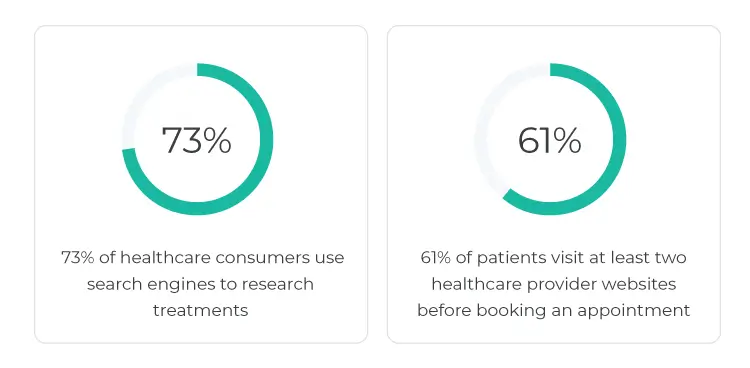
On top of that, a steady stream of new patients provide ample opportunity for sound care and good production. As new patients come into your office, you’ll have the opportunity to diagnose needed treatment. Patients who are switching dentists or finding a new provider after neglecting regular care usually require more care. According to Dr. Roger Levin of Levin Consulting Group, new patients often have 2-3x the production value of existing patients.
The key takeaway from these statistics: Most patients search online for dental services, and make decisions on which practice they’ll choose very quickly. If your practice doesn’t appear prominently in internet search results or if your practice’s website is poor or unappealing, you’re potentially shutting the door on the vast majority of new patients.
Brew some coffee, this is a long read
There’s a lot of information online about dental SEO and practice marketing, but in an environment awash in short tip lists and industry jargon, it’s hard for well-intentioned business owners to make sense of it all. That’s why we created this dental marketing course. Instead of providing a few out-of-context tips, we’ve opted to take a deep dive into online dental office marketing in order to explain the art and science of achieving visibility on the web.
Weighing in at over 15,000 words, the full dental marketing course is a bit daunting. But don’t worry, if you don’t have time to read it all now, just fill out the form below and we’ll email you a PDF copy to go through at your own pace. The PDF of the course contains links to how-to videos and downloadable resources that will help you get the most out of the course for your practice.
Download the dental marketing guide to read later.
How to Budget for Your Dental Marketing Plan
At the risk of coming across as tone deaf to our DIY audience, we’d first like to cover how to arrive at the best marketing budget for your practice. Whether you’re hiring a top marketing agency or doing all of the work yourself, chances are you’ll end up spending some money on your marketing activities. For the sake of the financial health of your practice, it’s important to know what you can afford, and it’s important to know whether or not you can afford outside help.
How much should a dental practice spend on marketing? Much like your investment strategy, the correct amount of investment in a marketing strategy depends on how aggressive you want to be. And as with most things in life, the answer on the correct amount of spend varies. While there isn’t a one size fits all metric that will work for every practice, there are a few tried and true methods you should be considering for yourself:
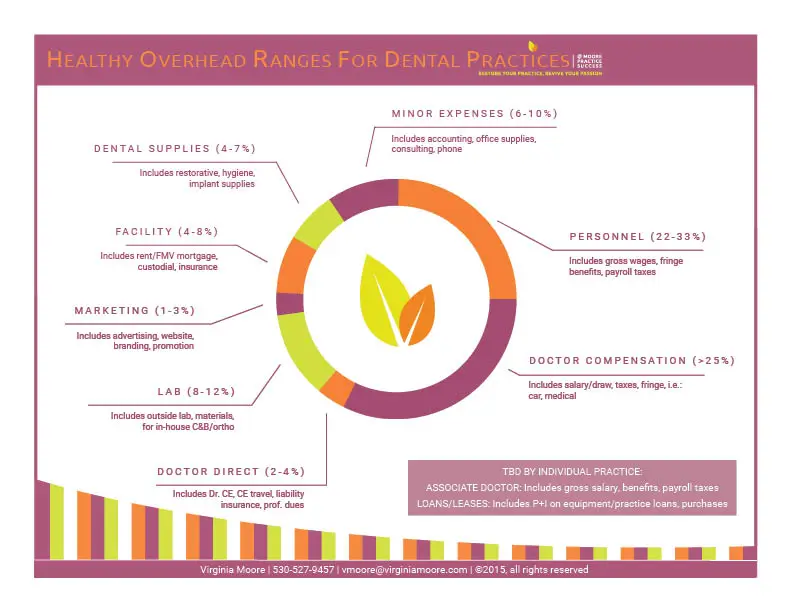
Budgeting as a percentage of overhead or production. A smart way many practices arrive at a marketing budget is by planning to spend a certain percentage of their total production. The key advantage of this method is that it’s financially sound. To arrive at a number, leading dental management consultant Virginia Moore has some valuable numbers on what constitutes a healthy level of spending or overhead cost for marketing and other segments of your expenses.
If you’re not sure where to start with your marketing budget, try using these percentages to compare it to other known expenses in your practice, like your lab expenses or dental supplies spending. (We’ll do the math for you; to stay healthy, a dental practice should be spending about half the amount on marketing that it does on supplies.)
Each of these categories of overhead expenses varies, of course, depending on the practice and the individual dental services provider, as well as additional factors like loans and staffing. But if you know where you fall in one or more of these categories, position your budget at a similar point in the range for the others, and you’ll be headed in the right direction. As an example, if you’re spending about 6 percent a year on your building rent and other facility expenses, that would put you mid-range, so you’d want to look at spending about 2 percent of your overall budget on marketing.
While working off of a healthy financial benchmark is the best place to start, a key disadvantage of budgeting as a percentage of production is that it doesn’t take into consideration what your competition is up to. To have the best results, take a look at how your top competitors are spending their marketing dollars and try to consider how you can match or beat their reach within the share of budget you’re able to spend. In marketing, money isn’t always everything, so zeroing-in on the most effective methods might help you beat a well-financed competitor without breaking the bank.
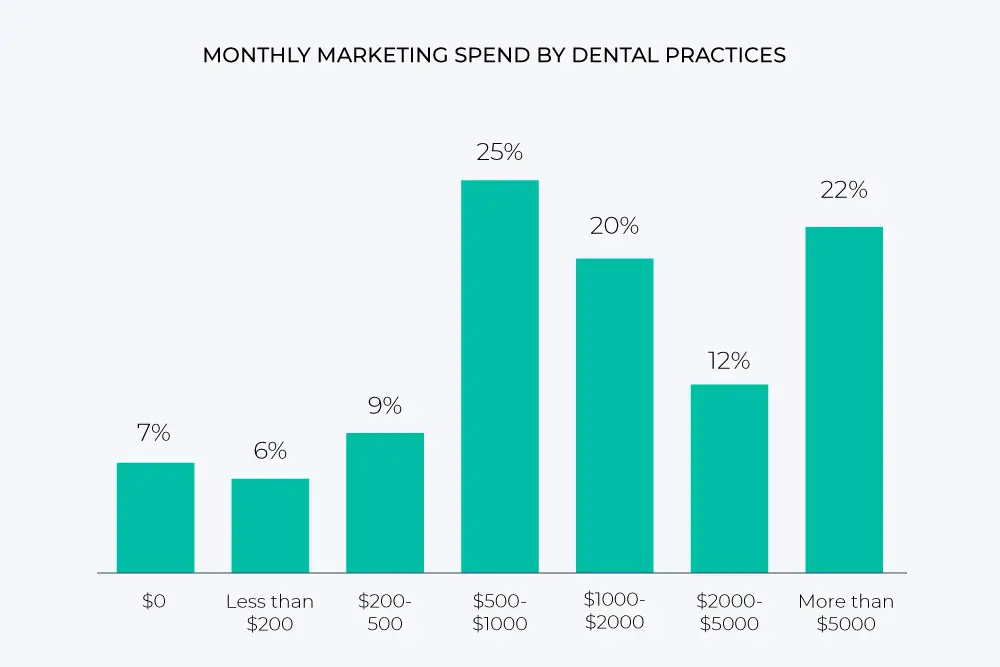
Budgeting to keep up with the Joneses. While it’s always best to know what you can spend before you spend it, it pays to understand the budgetary firepower you’re up against too. If you’re budgeting to keep up with the competition, try your best to align your budget with benchmarks of what your local or national competition might be spending –within reason– this method isn’t sustainable for every practice.
Take a look at this poll by Jim Du Molin from The Wealthy Dentist blog. Where do you fall in the range of surveyed dentists? Which of the mentioned practices are most similar to yours? Answering those questions can help you figure out what’s reasonable to spend, and what kind of spend will put you on par with the competition.
The poll reveals that about a fifth — 22 percent — of the dentists who responded say they spend more than $5,000 monthly on marketing. Over half, 54 percent, reach the $1,000 mark for monthly marketing expenses. Those who don’t spend anything on marketing? Only 7 percent.
The two most common responses settled in the $500-$2,000 range for monthly marketing spending, regardless of practice size, type and location. But the more competitive the market and the more specialized the practice, the more was spent on marketing. Some practices reported figures upwards of $10,000 or even $50,000, although they were far from average.
We recommend a combination of the two. Keep track of what does and doesn’t work for your practice. Tracking each marketing effort to determine what kind of ROI (return on investment) it’s providing for you is always worth the time to help you improve your budgeting for the future and make sure you’re putting your money where it’s doing you the most good.
Evaluating your practice’s spending on all forms of marketing might be daunting, but these estimates and tools can help you assess yourself in comparison to what other practices find works for them, and to what a healthy practice should expect to spend.
Intent: the 6-letter word that can make or break your practice’s marketing strategy
One last thing to cover before getting into the nuts and bolts of effective marketing strategies… We’d like to introduce one concept to frame the whole discussion: intent. It’s a simple but important concept that will help you understand how likely a marketing strategy is to produce results. Put simply, a buyer’s intent describes how much they want to take an action that will result in becoming a patient. Buyers with high intent are actively looking for a dental services provider. Buyers with low intent might have a dentist they’re happy with already or (gasp) not really care that much about keeping regular appointments with a dental professional.
In terms of a successful marketing strategy, your practice needs to reach people who have high intent to buy, or in other words, people who are actively looking for dental health services and plan to book an appointment with the best option they find.
Make sense? Sure. But in terms of your marketing priorities, different marketing tactics might reach people with differing levels of intent. For instance:
- Someone opening their mailbox may have high intent to receive a package, but they might not have high intent to find a dentist. While things like direct mail might generate some results for dental practices, generally speaking, if your strategy focuses solely on direct mail you might be reaching people who aren’t actively looking for a dentist and therefore are considered to have low intent. It would be reasonable to assume that these low-intent buyers would become patients at a relatively low rate.
- On the other hand, someone who goes to Google and searches for a dental implant specialist… now that’s an example of high intent. They’re actively looking for a specific service, so it’s reasonable to assume they’re in the market to make a decision on a provider and book an appointment. If your marketing strategy targets internet searches, you’re probably reaching important high-intent buyers who plan to make a decision on a care provider very soon.
In our opinion (and based on successful campaigns we’ve executed for clients) the best strategies put search engine marketing front and center. The reason is simple– when a patient is searching for a service, they’re typically ready to make a decision on a care provider. This immediate intent to make an appointment typically results in a better return on investment than marketing focused on patients who aren’t actively searching for a dentist, for example, patients you might reach through direct mail or social media. For that reason, this guide will focus primarily on digital marketing strategies which focus on intent, like search engine marketing.
The Most Important Dental Marketing Activities:
When it comes to succeeding at marketing on the web, dental practices need to focus their efforts on a few important fronts. This isn’t to say that marketing efforts that fall outside of the material covered in this guide are not important– they are– but we’ve found that the most effective ways to attract more patients focus on these three inter-related fronts.
The key factors in the success of any marketing campaign center on the ways a practice attracts traffic and how well their website turns visitors into patients once it’s found. An effective dental website, a strong SEO campaign and a smart paid search strategy are the three most important factors affecting the online visibility of dental practices, and we’ve dedicated chapters to each of them. If you want to jump to any of these sections, just click to them directly using the links below:
- The Elements of an Effective Dental Website Design
- Dental SEO Ranking and Visibility Factors
- Paid Search Strategy for Dental Marketing
Because of the way online marketing works, each of these three factors can rely on and influence one another. For instance, the rate at which patients bounce affects your website’s ability to rank highly in search results. Since none of these marketing factors exist in a vacuum, having a concerted strategy can help your practice achieve the best results possible.
So without further ado, let’s get into the first, and arguably most important factor of a successful online presence, a dental practice’s website.

The Importance of a Great Dental Website:
One of the most important factors of a successful dental marketing presence is a dental practice’s website.
An eye-catching and effective dental website is the cornerstone of any dental marketing plan. Research shows that 61% of patients visit two or more provider websites before booking an appointment. In order for your dental marketing plan to be effective, your website needs to catch the attention of potential patients and convince them that your practice is the right option for them.
Three key goals in executing your dental marketing plan are: attracting patients to your website through search engines, keeping them on your website once they find it, and getting them to book an appointment. Your website’s ability to engage searchers and turn them into patients creates a feedback loop with Google that can influence your success. If searchers are consistently finding their way to your website but immediately leaving because the page they’ve landed on is slow to load or irrelevant, you may have a harder time attracting more searchers in the future. But if searchers are spending time on your website, visiting several pages and filling out forms to contact your office, it can set your practice up for long-term success.
Online marketing is metrics-driven, so if you drop the ball with your website, achieving results with the rest of your marketing efforts can be a tough hill to climb. This is why we’ve chosen to focus on your website first in this guide. In this chapter, we’ll let you know everything you’re going to need on your website and what you can go without. You’ll also learn what types of pages work best for dental practices and what your patients and potential website users are looking for when they arrive on your website.
Check out this blog post to dig a little deeper into the specifics about how website engagement affects SEO.
If you don’t have a website, you need one. Here are a few options:
Having a website is absolutely integral to competing online. It tells searchers (and Google) what services you offer, how to reach you and why to trust you. If you don’t have a website yet, consider using one of our marketing-optimized themes to get started. We’ll do all the work needed to create a unique website that you’ll be proud to show off to patients. Each comes with a service package that’s designed to help you bring in more new patients each month.
If you don’t have the budget for professional help, we recommend using a simple service like Wix or Divi to cheaply build your own website. While going the DIY route may not get you all of the speed, function and design-appeal of a site that’s been professionally built, it’s a great place to start.
Assuming you do have an existing website, here are a few of the essential elements your site will need to compete.
Essential Pages on Your Website
Every practice is different, and each dental practice website should be too. However, there are certain components that any dental practice website must have in order to be effective. From our analysis of our clients websites, there are a few pages on each website that receive the most attention from potential patients. Beyond those pages, there are additional pieces of content marketing that can help make a practice’s website easier to find or help patients take important actions, like paying a bill or leaving a review. Below, we’ll go over each of these content marketing components and explain what sort of information the most effective practices have on each page.
Home Page:

A dental website’s homepage is the most important page in its site architecture. Because of several technical factors, your practice’s homepage is the most likely page to show up in search results, making it the perfect place for a great first impression. It’s often also one of the largest pages on your site, and the one that will be best designed to direct patients to other pages on your website while searching for the kind of in-depth information they need on the services you offer.
The primary purpose of a dental website’s homepage is to efficiently and effectively direct users deeper into your website. It’s important that your homepage mentions the types of services you specialize in very clearly to draw a visitor in and help them decide whether or not your practice is a good fit for their needs.
From a technical standpoint, a dental website homepage needs to have a sufficient amount of text on the page to satisfy search engines. Search engines are great at reading and understanding text, but they can’t see images the way we can. Instead, they rely on image alt text to know what an image depicts.
Balancing the needs of patients, who prefer cleaner, image-focused websites, with search engines, who require text-based content, is a key design consideration for dental homepages. A good amount of text for a homepage is at least 300 words, which doesn’t sound like much, but can be difficult to achieve when including images and a healthy amount of white space for aesthetic attractiveness.
On top of that, make sure all of your website’s important text and headlines appear as readable text, not as part of an image. (If you’re unsure whether text on your website is real text or part of an image, try highlighting the text with your cursor. If you can’t and instead your mouse appears to drag the image out of place, the text you’re reading might be part of the image.) Simply put, if your homepage doesn’t have sufficient text content, it will be difficult to get your website to appear in search results.
While the aim of your homepage should be to entice visitors to explore the services you offer, your homepage also needs to have options for patients who want to get in touch or book an appointment quickly. Displaying your phone number, a “contact us” link or a booking button prominently on your homepage is important to encouraging these interactions. Many dental websites even add a booking button to a sticky navigation bar, which appears at the top of the page even as the user scrolls, so a way to get in touch will always be available quickly.
In addition to information you’ve created about your practice, visitors often want to hear directly from your current patients. Adding verified patient online reviews or testimonials to your homepage is a great way to do this, as they let patients know about the great experiences others have had at your practice. Review aggregation tools can help pull a stream of live-updating reviews from Google, Yelp and Facebook relatively easily and inexpensively.
Dentist Profile Pages and About Us Pages:
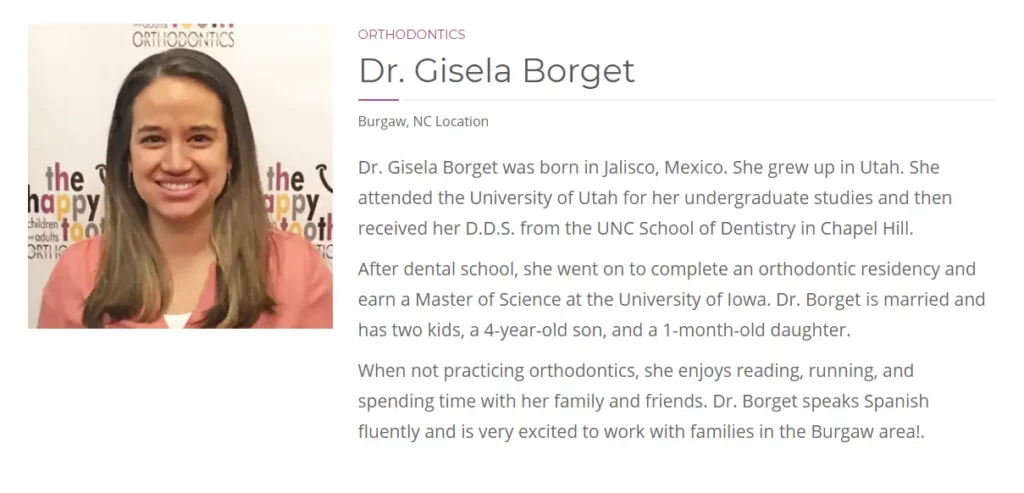
After the homepage, the most-visited pages on dental websites are typically profile pages for the doctors. Before booking, most patients will want to read about a dentist’s education, understand their background and see a photo of them. Having pages about each of the dentists at your practice in an easily accessible location is important to the success of your website, not only in the eyes of patients, but in order to convey your authority and trustworthiness to search engines.
When writing profiles about the dentists at your practice, take care to include information that conveys their authority in the field and their expertise. Mentioning their education and industry affiliations can help show the dentist is a credible and experienced provider of care. Mentioning the doctor’s family, hobbies and charitable activities is important as well. These personal details help patients see the doctor as a real, compassionate person and can aid in putting them at ease, especially if they’re nervous about seeking dental care.
Aside from knowing about the dentists themselves, patients often want to know about a dental practice team as a whole. Use fun photos to show off your team’s friendly personalities and include attractive photos of your office on your About pages to reassure a patient that your dental practice is the best option for their care.
Service Pages:

As a rule, each service you offer should have it’s own page on your website. Aside from providing in-depth information about different treatments the practice specializes in, individual service pages have a higher likelihood of appearing in results when a patient searches for them by name, which makes them a winning component of any strategy.
Service pages should contain a good amount of text-based information about each service your practice offers. 300-500 words is a good length to aim for. Good service pages also contain information like the basics of a treatment, what the patient should expect and how they should prepare for an appointment.
Since service pages can appear in search results, it’s important for them to make a good first impression and include much of the information a patient needs to know before making a decision to book an appointment. Service pages that either include or easily link to doctors’ profiles, online reviews from patients, and booking links tend to perform better than those that don’t.
Pro Tip: When planning out the service pages on a dental website, the goal is to provide sufficient detail without getting carried away with specifics that aren’t meaningful to the patient. Always consider the amount of information an average patient would need when making a decision about your services. While a patient might know they need a dental implant, it’s not always helpful to create a separate page for an impression implant and a CAD/CAM implant, even though a dentist would probably consider them to be two different services. A single page focusing on dental implants can provide enough information for the patient without bogging down the website navigation.
Contact & Booking Pages:
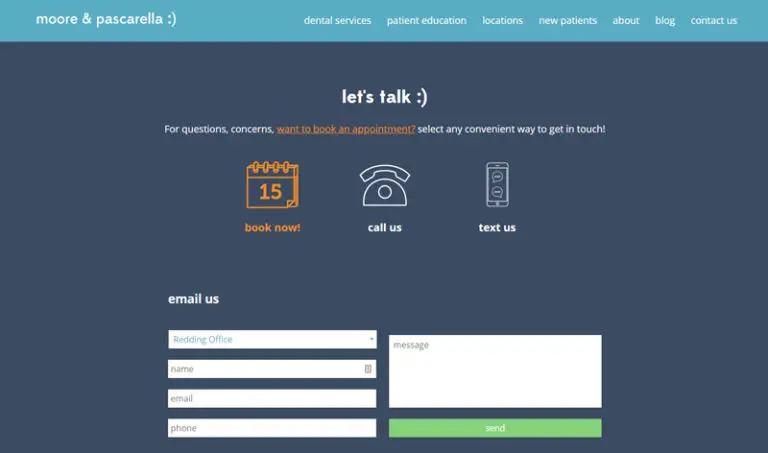
Of course, the goal of any dental website is to get patients to call your office or book an appointment for your services. A website should have an easy-to-use contact page or booking portal that’s accessible from anywhere on the website.
It’s important to recognize that patients are busy people and accommodate them with a variety of ways for them to book an appointment. In addition to a standard contact form, many dental practices are providing convenient ways for patients to request an appointment on their website, or even message or text their practice. Selecting a booking process that works well for your practice is a must-have for any dental website.
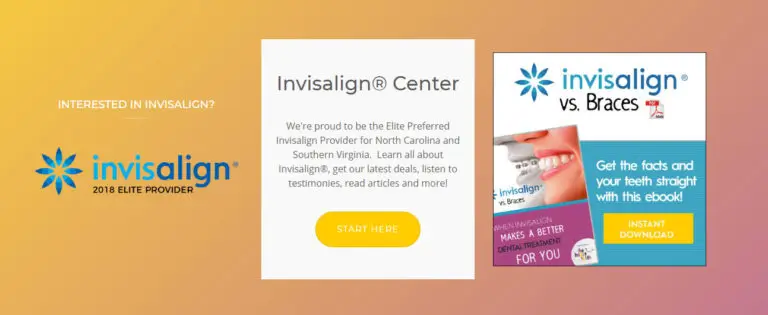
Blog:
While it’s not essential, many dental websites include a blog or resource library to provide patients with additional information and to help increase the search visibility of their website. The primary value of a blog on a dental practice website is to give patients more information. Showing up in more search results is, of course, a desirable side benefit.
Additionally, blogging is a great way to create content that you can send to other publications in hopes of getting featured, which can not only boost your clout as a professional, but help search engines trust your website as a whole, resulting in more visibility. We’ll elaborate about this in our section about SEO and link building.
We talk more about how blogging can help your business in our own blog.
Reviews Collection Page:
Including an online reviews page on your website, or a process by which patients can review your practice, is also a great idea. Gaining authentic, positive reviews is an effective way for a practice to stand out and gain more visibility in search results, however, a lot of patients find the process of leaving a review difficult. Building a page which links patients directly to your profile on the websites you most want to collect reviews on is a great way to facilitate the process of leaving reviews.
General Patient Info Pages:
Lots of dental websites also include patient information pages on their website, which are great places to add information about insurance policies, privacy policies and new patient forms. Offering patient forms online is a great way to streamline a patient’s experience in your office.
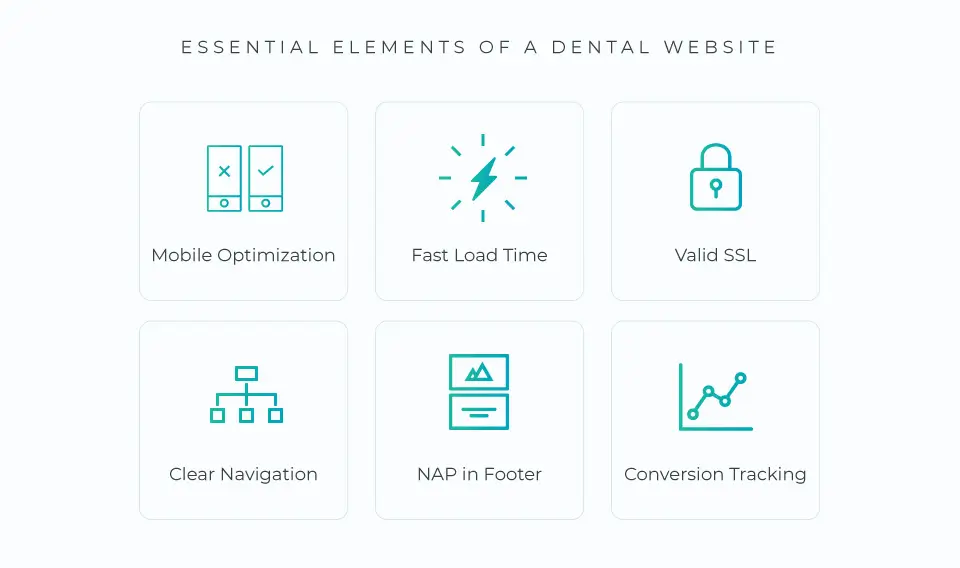
Advanced: Essential Technical Elements of a Dental Website
Website technology and the factors search engines look at are always changing, so the same website that worked for your practice five or ten years ago is probably less effective now. Keeping up with technology and continually investing in your website are a must, but there are a few technical items that have become prerequisites for creating a successful website. Whether you’re working with us to design a custom website for your practice or handling it yourself, these are some of the first considerations you should have on your radar:
- Dental websites need to be mobile-optimized: Dental websites absolutely must work well on mobile devices. Lots of patients search for dentists on their smartphones, so having a mobile-optimized website is an absolute necessity. If a mobile visitor can’t read the text on your website, easily navigate the site or see information about the services you offer without zooming in and out on their phone, it’s likely they’ll click the back button quickly, an action which may drag down your search rankings.
- Dental websites need to load quickly: If your website takes more than a couple of seconds to load, patients won’t stick around. Google published a study in 2018 that shows you lose about a third of visitors if it takes longer than three seconds, and at five seconds, you could be losing up to 90 percent of your visitors before they even see what you have to offer. The need for fast load time becomes even more important when people are visiting your website from a mobile phone, which could be using a slower cellular network.
- Dental websites need to be secure: Aside from basic patient privacy concerns, Google has begun highlighting websites that don’t use SSL certificates as unsecured. Dental websites should have a valid SSL certificate at all times, which is an inexpensive way to build trust and convey authority. Many website hosts give away SSL certificates for free. If you have a WordPress site, we recommend using Flywheel.
- Dental websites must have clear navigation: As patients decide whether you’re the right dental practice for them, they’ll need to find information about the services you offer and your credentials. Clear and user-friendly navigation is essential to any dental website to help facilitate the patient’s search for information.
- Dental websites need to include the practice name, address, and phone number (NAP) in the website footer. Since dental practices are location-based businesses, it’s important that patients and search engines alike know where to find your place of business. Include your dental practice name, address and phone number in your website footer and take care to ensure your NAP is accurate and formatted consistently everywhere it appears online. There’s more on this in our dental SEO section, later in this guide.
Once your website includes the most important pages and technical elements we discussed in this chapter, it’s time to move on to complete some of the more technical tweaks that will help your site appear more often in searches. Luckily, the pages we’ve recommended you create will serve as an excellent foundation to the optimizations we recommend in our next chapter, which focuses on search engine optimization.

How to Create a Dental SEO Strategy
Building a website alone isn’t enough to achieve a steady stream of new patients. It’s kind of like opening a business on a back street that doesn’t get much foot traffic. You can set everything up just right, but you need to create traffic in order to bring in customers. In short, you can have the most beautiful and effective website on the block, but if you don’t take the steps to help people find it, you’ll never be found.
The power of local search visibility for dentists is undeniable. 80% of consumers use search to find local information, so neglect this valuable dental marketing channel at your own peril. When patients are searching for a dentist, they go to local search first, reading reviews, looking at photos and vetting the websites of different practices. A well-run dental SEO campaign is critical if you want to capitalize on this steady stream of new, interested patients.
In this part of our dental marketing guide, we’ll focus on how to practice good dental SEO to attract patients who are actively looking for a dentist. While Google doesn’t publish its search algorithm for obvious reasons, it does provide lots of hints and guidelines on how to produce the best content and website. The SEO industry also shares information with one another about what works and doesn’t, resulting in a common body of knowledge we use to create websites and website content that appears highly in searches.
To provide some clarity, we’ll be going over the main local ranking factors Google uses to determine search engine ranking, as listed in the Local Search Ranking Factors study, a body of research that’s published regularly by Moz, a leading SEO software company.
Based on the study’s findings, we’ll break down each of the search ranking factors for dentists one by one, in order of their importance. To help you make the information more actionable for your dental SEO strategy, we’ll cover what dentists can do to use the factors highlighted in this study to their advantage.
Key Concept: Domain Authority
When it comes to understanding why one website might appear more often than another, the metric a lot of search engine optimization professionals look at is something called domain authority. Domain authority is a metric that Moz, a leading SEO software company, created to predict the likelihood that one competitor would outrank another. Without getting too technical, it distills a bunch of factors into a simple number on an exponential scale from 1-100. The higher the number, the higher a website’s potential to outrank its competitors with lower scores.
The key takeaway here is about a website’s competitiveness. Generally, more established websites have a higher authority than new ones. A smart SEO strategy recognizes that websites with lower authority usually don’t outrank those with higher authority and finds clever ways to compete, all while undertaking optimizations meant to boost authority.
How do you build domain authority? While the exact math isn’t public, SEO best practice says that it’s by optimizing for all of the important factors we’ll cover as a part of the study below.
Dental SEO Ranking Factors
In SEO ranking, we differentiate between two types of local search rankings, because searchers end up at your website in two different ways. The first covers a couple of methods Google uses to provide geographically localized search results with more prominence: Local packs and local finders. That’s SEO jargon, but you probably know these as the results that show up on the top of a Google search, the ones boxed separately with the map and recommended by Google for your search terms.
It’s great when you can rank highly in these local packs, because many users are going to choose from the top results Google gives them. We’ll talk about how all these factors affect whether or not your site is getting seen in that box as we go through this section.
The second type of local search ranking is local organic search, which is everything that appears below those packs. Doing well here is also important, and getting your site high up in these rankings relies on slightly different factors. Both have the potential to bring a fair amount of traffic to your site.
Particularly strong websites with higher authority and more mature web presence have a better chance for ranking in organic results. To have the best shot at success, your practice should be working hard to optimize for both.
In the section below, we’ll cover all of the most important factors and give you a crash course on how to optimize your website for each.
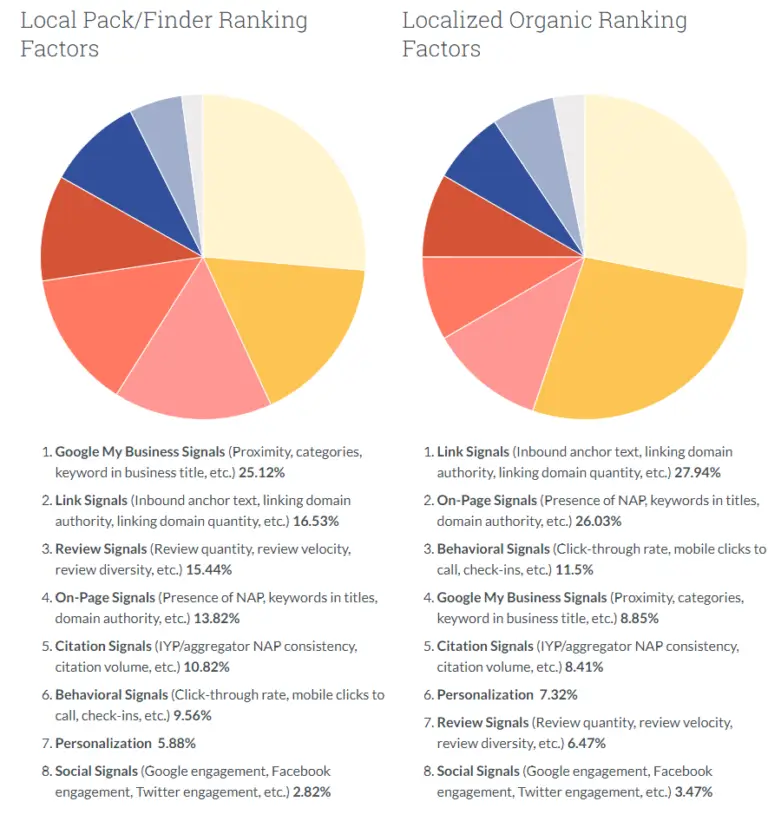
Google My Business Signals
The most important single thing you can do to better your SEO rankings is to optimize your Google My Business presence. Over the last year, it’s become the top factor in getting your site seen in searches.
If you or a prospective patient Google your practice name, your Google My Business profile is the panel of information and photos that typically comes up on the right side of your screen. The profile is free, easy to edit and packed with features that can help patients learn about your practice and services. It consists of a profile with the practice name, address, phone number, website, reviews, photos and more. Google continues to make Google My Business more robust for users and adds features to it from time to time, so it’s good to assign profile access to the agency or person in your office who handles your dental marketing so they can keep up on new developments.
Google is in the business of serving up information, so naturally, they want to make sure the information they provide is accurate. When you create a Google My Business profile, Google may send you a postcard to verify your address, which is part of the way they help ensure their local results are accurate. When you have an active, verified and optimized Google My Business profile, Google gives your site more visibility in search results, making this the most important ranking factor for dental marketing. It might even be equal in importance to your website itself. We’re seeing a tendency for searchers to choose a Google My Business profile to find information, rather than the business’s website. Because Google has built such comprehensive resources into their Google My Business offerings, it’s often the case that a potential patient can find what they need and contact you through your GMB profile, without ever seeing your website.
If your practice hasn’t already set up a Google My Business profile, you can set one up here. It’s the best thing you can do towards increasing the visibility of your practice.
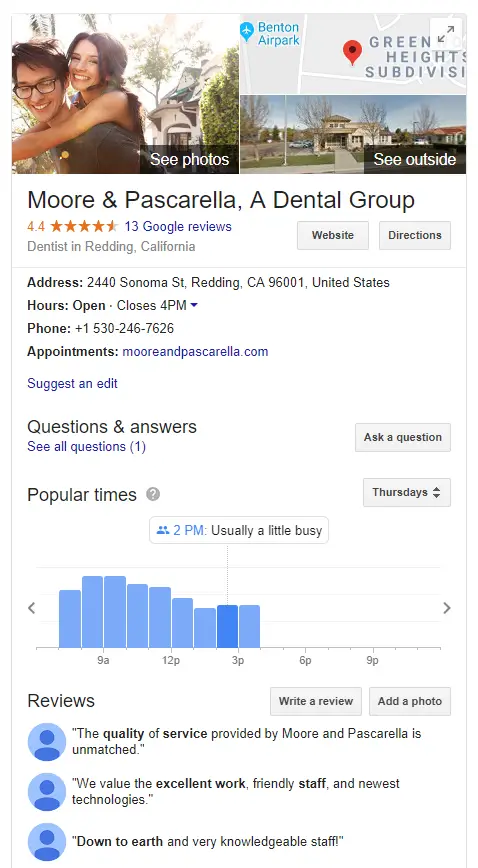
If you’re logging into Google My Business for the first time, the dashboard can be a little intimidating. It’s well-designed and intuitive, but there are a bunch of features nested into the options on your left-hand sidebar. Some sound similar to one another, and since the information you fill out is likely to be seen by thousands of searchers each month, you want to be sure you’re filling it out correctly. On top of that, the information you add to your Google My Business profile often gets passed around the internet to populate other websites with information about your business, so it’s critical to avoid a few common snags.
The info in this post reflects the design of the Google My Business account dashboard as of May of 2020, so if you’re reading this post later, the location or availability of some of these features might be slightly different.
Here are the features you’ll want to optimize in your account:
Features under the Info tab:
- Name, Address and Phone Number: Your name, address and phone number (called NAP in search industry jargon) are the most important pieces of information on your profile, as they’ll be passed around the internet to other websites with an interest in displaying business information. Consistency is important not only to get prospective patients to the accurate information about your practice, but because search engines look at the consistency of this information to judge whether it’s correct. Inconsistent NAP info might result in your practice appearing less often in searches. Ensure your dental practice name, address, and phone number is exactly correct and in a consistent format anywhere it appears online. Pay attention to the details in your NAP, like commas in your business name or whether abbreviations exist in your address.
- Business Category: For many practices, it makes sense to add Dentist as your primary business category, then add one to three relevant additional categories. Additional category options for dentists include, cosmetic dentist, pediatric dentist, dental implants periodontist, and dental clinic.
- Service Areas: If your practice regularly sees patients from outside of the geographic boundaries of the city listed in your address, it makes sense to add them as service areas. Take a few minutes to think about the surrounding towns your patients come from and add a few of them to the service areas in your profile.
- Hours of Operation: Add your normal, correct hours of operation to your profile here.
- Special Hours: Add correct hours for holidays and one-off days that you might be closed or closed early for things like team training.
- Profile short name: Marked by an @ symbol, this is where you can set an abbreviated name for your profile, making it easier for you to share a memorable human-friendly link to your profile, rather than the long URLs that Google typically uses for profiles.
- Website: marked by a globe symbol, this is where you’ll want to add your practice’s website address.
- Appointment link: if you happen to have a page that patients can use to book or request an appointment on your website or on a third-party service like Limelight or LocalMed, add the link here. If you don’t have a special booking page, adding a link to a contact us page can work too!
- Menu: The menu option on Google My Business isn’t very aptly named for dental practices and you might skip right over it on your profile, assuming it’s only for restaurants. However, if you have a page on your website that lists off all of your services, add it to the menu field on your profile. The label will magically change to “services” and display on your profile when you do.
- Products: Google’s products category is very similar to the Services category we’ll cover next. While dental practices might automatically assume that filling out the Services category is more appropriate for the way they do business, the products category comes with an added benefit: each product you add allows for you to upload a photo to it and the list of the products you add appears directly on your profile in search results. If you elect to use the products category, you’ll be prompted for a price for each product, but it’s not a mandatory field. While there’s no evidence that filling out one section is better than the other, if you’d like to opt for a more visual list of your services, we recommend you list them out in the Products category rather than in Services.
- Services: The list of services on your GMB profile doesn’t appear anywhere visible on the profile yet, but many suspect that the information added here can help in voice search results, like if a patient used their Google Home of Alexa smart speaker to ask for a local dentist who offered teeth whitening. This blog talks about how to add your services to your Google Business profile. We recommend creating an entry for each service your practice offers along with a short description.
- Attributes: In the following 5 sections, Google allows businesses to add a series of attributes to their profiles which patients might want to know about. You can list your business as veteran or woman-owned, add info about wheelchair accessibility, amenities, LGBTQ friendliness, and accepting new patients.
- Description: Google allows dental practices to write a description of their practice that appears on their My Business profile. Including natural keywords in this space can have an effect on search ranking, so adding a complete, robust description is important. However, don’t go overboard. Excessive use of target keywords (like “dentist in [town name]”) reads poorly and could result in spam penalties. There’s a limit of 750 characters on this description. We recommend filling up the space, but with the limit in mind, you’ll have to keep what you say relatively brief!
- Opening Date: This is a place to add the date your practice was opened.
- Temporary COVID-related fields: There are two new fields that Google has added to the Info section of the Google My Business dashboard. You can link to a COVID information page on your website with one, which we assume will eventually be removed as an option. Additionally, a new field for Virtual Care has appeared on healthcare related profiles. If you offer teledentistry as a service and have a page for it on your website or have a booking portal for patients to use, link it here. This option might be here to stay!
Features under the Reviews tab:
- Reviews and responses: Reviews themselves are part of the local ranking factors, and your Google Business profile is the best place to collect them. Ask happy patients to leave reviews on your profile in post-appointment follow-up communications, and then respond positively and professionally when they leave a review, good or bad. When you navigate to the Reviews tab in your dashboard, you’ll see tabs for All, Replied and Haven’t Replied. We recommend all dental practices take the time to write a short thank you note to all of the patients who’ve reviewed you positively. If you come across a negative review, we recommend responding to the review kindly and objectively, using your response as an opportunity to show the reviewer and other readers that you’ve actively tried to remedy any situation that resulted in a poor review. To learn more about collecting reviews, check out this blog.
Features under the Messaging tab:
- Messaging: Messaging is an option dental practices can enable to communicate directly with patients who’ve found their Google Business profile and have a question or want to communicate quickly with a member of your team. If you choose to enable messaging, it’s important to have a team member in your office ready to respond to patients in a timely manner.
Features under the Photos tab:
- Photos and Videos: Photos and videos are one of the most viewed parts of any Google Business profile especially as patients compare multiple dental practices to decide which ones to contact. It’s extremely important to add attractive photos to your listing. The best photos to add are pictures of the interior and exterior of your office, photos of your team and photos that reflect your brand. Good videos might include any promotional videos you have, or a virtual tour of your office. We recommend regularly adding new photos to your profile, as this is a signal to Google and potential patients that you are active and engaged.
Features under the Products tab:
- Products: While this option has already been listed in the Info section above, it’s also accessible directly from the Products tab. Google’s products category is very similar to the Services category we’ll cover next. While dental practices might automatically assume that filling out the Services category is more appropriate for the way they do business, the products category comes with an added benefit: each product you add allows for you to upload a photo to it and the list of the products you add appears directly on your profile in search results. If you elect to use the products category, you’ll be prompted for a price for each product, but it’s not a mandatory field. While there’s no evidence that filling out one section is better than the other, if you’d like to opt for a more visual list of your services, we recommend you list them out in the Products category rather than in Services.
Features under the Services tab:
- Services: While this option has already been listed in the Info section above, it’s also accessible directly from the Services tab. The list of services on your GMB profile doesn’t appear anywhere visible on the profile yet, but many suspect that the information added here can help in voice search results, like if a patient used their Google Home of Alexa smart speaker to ask for a local dentist who offered teeth whitening. This blog talks about how to add your services to your Google Business profile. We recommend creating an entry for each service your practice offers along with a short description.
Features under the Website tab:
- Website: If you already have a website, we don’t recommend doing anything with this tab. The website Google allows you to create here is relatively basic and a professionally-done website will usually be the better option. However, if you don’t have a website for your practice and are on a budget, creating a website from your Google Business profile is a good option to get something up and running quickly and cheaply.
Features under the Posts tab:
- Google Posts: Google Posts are short updates you can make to your profile, often accompanied by a photo, some text and a link or button. Posts are great because they appear directly on your profile in search results. On top of that, Google occasionally uses information from your posts to populate search results in other places. For instance, if you posted about an Invisalign special your practice is offering and then a patient searched Google for “invisalign providers near me” a portion of your post might appear in the Google Maps results along with a note that says something like “Their Posts mentioned Invisalign.”
The option to create a Google Post appears in several places in your Google My Business dashboard including the homepage and a separate Posts tab on the left hand sidebar. You should post about specials, information about your practice and more. We also offer some free Google Posts templates you can use to add a booking “button” to your profile using Posts.
Other stuff to keep up with:
- Q&A: Google encourages people who are familiar with your business to provide information about it or ask questions. Keeping up with Q&A on your Google Business profile is important, but Google doesn’t always make it easy to. When a customer asks a question on your profile, you won’t always receive a notification, so it’s important to Google yourself periodically and look at the Q&A section on your profile. Politely answer any questions that have been asked and not responded to adequately.
Alternatively, you can get ahead of common questions and use your Q&A section as a kind of FAQ resource. Just ask your own questions using a team member’s Google account and answer them using the business’ account to address frequently asked questions about your services or practice. - Insights: The insights tab in your dashboard is full of interesting information about how many people have recently called, requested directions or visited your website using your Google My Business profile. It also contains information about the search terms people are using to find your business, which is a great way to tweak the content on your website to attract more searches. You can also hand off this information to a dental marketing agency to get some professional help on optimizing your website to attract more patients.
Link Signals:
In dental marketing, getting quality links is one of the most challenging parts about achieving local search visibility for your practice, but it’s also one of the most important parts of the local search ranking equation.
Link signals refer to the number of quality links coming to your website, so in analog terms, consider each link a vote of confidence in the information you’re providing. In terms of search visibility, Google assumes that the more relevant and interesting a website is, the more people will link to it. All other things equal, Google shows pages with lots of quality links higher in search results than those without, underscoring the importance of building quality links for your practice.
However, not all links are created equal. Links coming from high authority websites, carry more weight than links coming from low authority sites. There are tools you can use to measure the authority of a website, but for the purposes of inbound marketing for your practice, a common-sense test can apply just as well: the authorities in the dental industry are often some of the best links to get.
Links from professional associations & industry publications:
When it comes to links from industry authorities, make sure all of the dentists in your practice maintain active profiles with the industry associations they’re a part of. Most associations, like the ADA or your state dental association, have a field on your profile for your website address. Ensuring this link points to your website is an easy win. Simply making sure all of the doctors in your practice have their association profiles linking to your website can make a big improvement in your practice’s link profile and domain authority.
To dig deeper into getting links from industry authorities, your practice typically has to be engaging in something out of the ordinary. If you’re offering a new or novel treatment and have information that other dentists might find useful, consider writing an article about it and pitching it to the editors of industry sites like DentistryIQ, Dental Economics or the RevenueWell blog.
Links from public blog sites:
Gathering less authoritative links can still be helpful as well, and maintaining a blog is a great way to create content you can use to attract links. Several industry sites allow you to maintain your own blog such as DentalTown. Posting your blog content on Medium can help expose it to a new audience and give you an opportunity to include a link back to your website. A good way to do so is to include your website link in your biography or in a sensible place within the post where a reader might find it helpful, like to elaborate on a treatment you mention.
Links from local sources:
Collecting high authority links to your dental website is important, but getting locally-relevant links is of equal importance. High authority local websites are places like the Chamber of Commerce or local dental industry groups your practice might be a part of. Whenever possible, join local associations, sponsor local events and be active in your community. All of these offline activities can help generate links to your practice’s website from other local websites. Don’t be afraid to ask for a link as long as you do so in a way that adheres to Google’s policy on links. In general, getting a link from an event you sponsor or from a Chamber of Commerce directory is fine.
On Page Signals:
While the top two most important signals in the local search ranking equation are considered “off-page” signals, or attributes that originate outside your site, the third, “on page” signals, relates to the content you control directly on your dental website. Search engines primarily index the text on pages from your website, so it’s extremely important that your website includes well-optimized text-based content and checks all the boxes to reassure Google that you’re a good provider of the services you offer and that your place of business is where you say it is.
When most people think of SEO, on-page optimization is what comes to mind. It’s the methodical tweaking of content to improve how useful it is to visitors and how Google “grades” it. The on-page signals this ranking factor takes into account are a fairly complicated part of good local SEO practice, and more in-depth information about on-page ranking factors can be found here.
Without getting too far into the weeds, optimizing a page entails finding a search term or phrase that you want your page to appear for, and then using the keyword in a few important places on the page.
Good on-page SEO is important and takes research, skill and continual improvement. SEO agencies typically use pricey software to conduct research into the best possible keywords to target on a page, given your competitive landscape and your website’s authority. If you’re the DIY type, using common sense can still work in a bind. Think of what you’d search for if you were looking for the website page you’re optimizing, for example, optimizing your implants page for something like “dental implants in [town name].” Here are the most-applicable on-page ranking factors for dental websites:
- Target Keyword: This is the term you most want your page to appear for. If you’re optimizing your page by yourself, you can “shoot from the hip” and take a common sense guess at what this term should be. Or you could purchase a piece of software like Moz or SEMRush to receive suggestions, competitiveness scores and search volume estimates to help guide you to the best option.
- Page Content: The content of your page is what makes it noteworthy in the first place. It has to convey the necessary relevance on a topic to deserve a Google search placement. When writing page content, the best thing you can possibly do is think about what information a patient would want to know. Then write it down in thorough detail, plain and simple. Google updates encompass a lot of things, but each update that rolls out seeks to reward content that answers searchers questions and demote content that seeks to trick or deceive them. You can ensure your content will always have a better chance of ranking by simply making your best effort to ensure a patient would find it useful.
Beyond simply creating good content, you can give yourself an edge if each page on your website does a good job of sticking to a single topic or target keyword. For example, if you’re using a page on your website to talk about dental implants your practice offers, provide a thorough explanation of what an implant is, the process of placing an implant, and what kind of patient it might be important for. Keeping the content of each page focused on one topic makes it easier for search engines to find.
When creating page content for a dental website, it’s important to write naturally and consider the patient’s informational needs. Don’t just try to include the target keyword as much as possible. It’s annoying to your page visitor and against Google’s guidelines, so doing so could hinder your page from ranking. Good on-page content for dental marketing is at least 300 words in length and mentions the topic of the page about as much as could be expected in natural speech. A good tool to optimize on page content is the Yoast plugin for WordPress. - Title Tag: The title tag is the blue linked text that appears in search results after your page gets indexed by Google. This is an on-page factor because the title of a page needs to be set on your website itself. Your title tag should include your target keyword and accurately reflect the topic of the page, but can also include things like your city’s name or something particularly great about your practice that might entice a searcher to click. Writing good title tags is a bit of an art form. Anything beyond 60 characters is truncated and cut off in the results, so brevity is key!
- Meta Description: the meta description is what appears below the title tag in a search result. Again, writing a good meta description is an art form. Usually about 150 characters in length, it’s a little longer and is a great opportunity to really sell your service or mention what makes your practice stand out. The purpose of the meta description is to elaborate on what a searcher can expect to find on the page. While your target keyword doesn’t directly impact rankings here, it’s still important to include it in your meta description, as Google bolds it in the description, which might help guide a searcher to click on your search result. Overall, it’s most important to use this field to be helpful to a potential visitor and accurately hint at the content on the page. Don’t use meta descriptions to be overly salesy or spammy.
- URL: The URL of your page is the internet address it occupies in the address bar of your browser. It’s best practice to include your target keyword in your URL in order to give searchers a hint about the information the page is about. It’s best not to use the auto-generated URL your website might spit out, which isn’t always the most sensible address to human readers. To keep following our dental implant example, an appropriate URL would be something like examplewebsite.com/dental-implants rather than www.examplewebsite.com/post=1004. Most website hosts and content management systems have a method for customizing URLs, and learning how to do so on your particular site will give you a useful tool.
- Image Alt Text: Search engines can’t read images, but patients expect to find them on a good dental website to make the design more appealing and easier to understand. An on-page optimization tactic many websites neglect is to add image alt text to each image used on your website. Image alt text is text-based content that gets tagged to an image, which search engines can read and use to understand what the image displays. When writing image alt text, the best practice is to include the topic of your page, and to write the alt text as if you were describing the contents of the image to a blind person, since of course, the search engine can’t see it.
Review Signals:
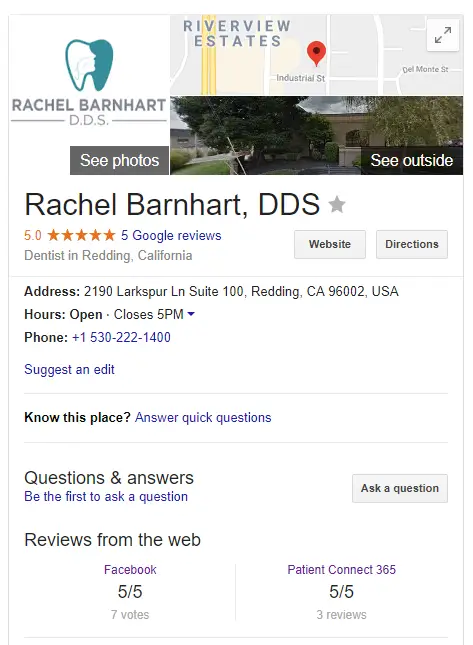
Reviews are an enormously important part of finding the right dentist for many patients. Search engines know this and build the number and rating scale of reviews into their ranking formulas. This makes collecting reviews and maintaining a great rating an important part of a dental marketing strategy. Google also has been placing more importance on review signals over the past few years, so inattention to these can really hurt your web presence.
The review collection policies of different websites vary, so before asking for reviews from your patients, know the policy of the site you’re asking them to complete a review on. For example, while Google allows dentists to ask patients for reviews, Yelp strictly prohibits it and will take down reviews that don’t adhere to its policy. For the purpose of this guide, we’ll focus on the most important place reviews can exist—on your Google My Business profile.
Google allows dental practices to solicit reviews from patients, but it’s never a good idea to be pushy about asking for reviews, or to simply ask for a review from any and all patients. The best way to go about collecting reviews is to build a review portal into your dental website and send out a review link to patients in post-appointment communications. Owning the patient review system you use can help your team to address the concerns of patients who might have had a less-than-stellar experience at your office before they write about their experience online.
While bad reviews can have a dramatic impact on your practice, they aren’t permanent. We recommend to our clients that monitoring reviews of the practice and all the practitioners in it should be a regular thing. You can work to improve those reviews with positive responses and actions.
It’s important to respond to reviews positively, especially if the reviewer has negative things to say about your practice. Reviews are a public forum, but people who read and write reviews are usually pretty rational. Correcting an issue or simply offering a kind explanation or apology can help blunt the destructive power of a bad review or even get the reviewer to change it.
Getting positive reviews and staying on top of the reviews patients leave are a key part to dental marketing and ranking well online. That’s why we always tell our clients their review strategies need to be monitored and reviewed periodically to get the most out of your efforts.
Citation Signals:
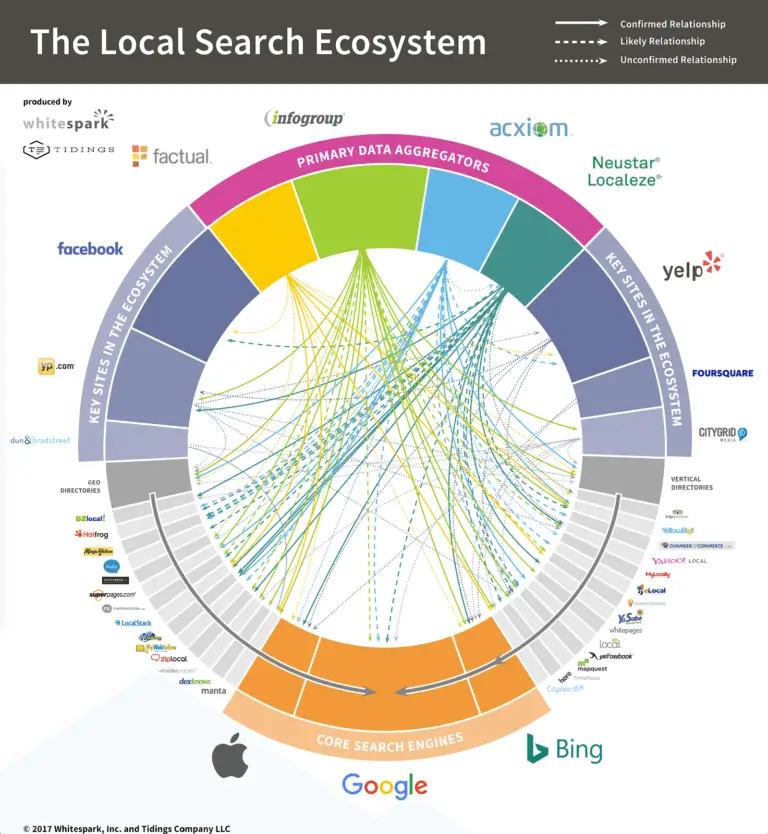
Citation means something specific in the SEO world: Anywhere your name, address and phone number appear online. This is often in a web directory, like YellowPages.com or industry directories.
The importance of this ranking factor can be inferred from the name–citations are how we determine authority and accuracy , and that’s also what citation signals do for search engines. Just like an academic citation shows that other authorities support the statement you’re making, online citations show that your office information is accurate. Citation signals can get messy for dental practices, and are a big factor of confusion for Google if they’re wrong. Again, since Google’s job is to serve up relevant, correct information, the search engine wants to be as sure as possible that the location of your practice is correct when it sends a patient to see you.
To put it simply, when information about your practice is incorrect, Google trusts the information you provided a little bit less and is less likely to display your practice in search results. Keeping your name, address and phone number correct across the web is a big factor in the accuracy of the citation signals Google takes into account.
But how many places could your practice information exist online? A lot more than you might think. Just as Google’s business relies on providing correct and relevant information, many other online businesses called directories make money by assembling business information. Directories might be industry-specific (ie: Healthgrades) or could be very broad, (ie: Yelp) but the important thing to your practice is that there are a lot of directories, and you need to ensure the important ones have accurate information about you.
Recently, search engines have begun to rely a little less heavily on citation signals, so it’s not in the top list of the most important SEO tasks, but there are some basics that you really do want to have right. We recommend to our clients that the top 50 or so directories should be checked for accuracy and updated, but beyond that, you’ll have diminishing returns on your efforts. Adding more doesn’t really improve your search ranking any further.
One of the most difficult things about directories for dental practices is that information about a practice can exist in a lot of different forms. Take, for example, a dentist who has just begun their career. After graduating from dental school and getting that first job, they might have created a profile on Healthgrades or made a Google My Business page for themselves as a practitioner to help patients find and review them. Additionally, someone else could have made a page for them, which happens often for dental professionals. Over time, a dental professional might change office locations, join a different company, go out on their own, or partner with another dentist, all of which would feasibly change the name, address or phone number of their practice, confusing the many directories and search engines that have built their business on serving up the dentist’s information.
When that dentist finally settles into a practice and begins working on their dental marketing, chances are, their information is very messy.
The citation/directory industry works with many aggregators collecting, assembling and passing information to one another, which works as a double-edged sword in dental marketing. On one hand, incorrect information can easily pop up in a lot of places very quickly. On the other hand, correcting that information doesn’t always require finding it and fixing it by hand on each directory it exists on. There are lots of SEO tools that can help a dental practice distribute correct information to directories in bulk.
The drawback of using directory distribution services like these is that once you stop paying for a subscription to them, the information sent to the directories can revert to the old, incorrect information. A good practice for dental marketing is to be fastidious with directory information and make sure it stays accurate as you progress through your career. For the most important directories, manually updating the information can ensure that the right signals are following you. Citation accuracy is tedious work, but a big part of a successful dental marketing strategy.
Behavioral Signals:
At the beginning of this guide, we covered how to create a good dental website and explained why a website is the cornerstone of your entire dental marketing strategy. This section deals with how people interact with a dental website and the signals their actions send to Google about its quality, so you may want to refer back to the section about websites for a refresher if your website scores poorly on any of the metrics mentioned.
Behavior signals on your website refer to the rate at which people click on your website when it appears in search, how often searchers use the click to call button on your Google My Business profile and other on-page factors, like bounce rate. When your website has strong metrics in any of these areas, Google takes it as a signal that the person it sent to your website found the information useful, which validates your placement in its search results. On the other hand, if searchers routinely don’t click on your website when it comes up in search results or if they immediately click back to the search engine results page after arriving on your website, Google takes it as a signal that your content is irrelevant or there’s a problem with your website.
If a page is hard to navigate, potential patients might not spend long on your site. But, when they leave quickly, the site isn’t rated as highly by search engines. The design, search factors and patient-friendliness are all connected, and having a concerted dental marketing strategy that addresses all three can help your practice achieve the best results possible.
As you might imagine, improving behavioral signals related to your website can be complex. There are a lot of variables at play, and each needs to be fine-tuned in order to keep a potential patient interested.
Here are four ways you can help boost behavioral signals:
- Improve click-through. Write relevant titles for your pages and thorough meta descriptions. These are the two main components of a Google search result that will attract clicks, so if your result doesn’t include these things, your website might get clicked on less often, a negative signal.
- Reduce bounce rate. Have a mobile-optimized website. Lots of people search for dentists from mobile devices. If your website isn’t optimized for mobile, it may be difficult to use on a phone making a potential patient click the back button and resulting in a negative signal.
- Improve time spent on your site. Keep an eye on load time. People don’t stick around long for a web page to load when they’re searching for information. Keeping your page load speed below 2 seconds by following best practices with your site and avoiding the use of lots of large images can ensure a searcher stays on your website long enough to read the content you provide. Load time is especially important to mobile users.
- Keep people on your site. Provide clear, relevant information. If you don’t feel like the link you clicked on took you to a relevant page, you leave pretty quickly. Patients are the same way, so be sure the pages you send patients to announce their topic quickly and clearly.
Maintaining a healthy, fast-loading dental website and regularly working to improve your behavioral signals will be rewarded by more prominent search placement and greater visibility for your dental marketing efforts.
Personalization:
In local search marketing, personalization refers to information about the searcher that Google knows because of their country, location or browsing history. While personalization based on browsing history doesn’t play a large role in local search, geolocation certainly does, and proximity to the searcher plays a big role in Maps searches. In short, where your practice’s website appears in Maps search results is sometimes directly dependent on where the searcher is. When searching in maps or when seeing results from a map pack, Google typically displays results closer to the searcher when the search is general and doesn’t include any kind of location modifiers.
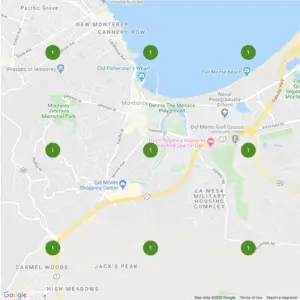

Take for example this Maps search result, generated using the Local Falcon SEO tool, which tests the maps rankings for a business in different locations from around a city. The dental practice we tested ranks #1 for “dentist in Monterey” from everywhere in the city. However, when searchers don’t specify a location and just search for “dentist” the results vary widely, based on the dentists that are closest to their location. That’s geolocation personalization at play.
So even if your website is well-optimized for the town you do business in, you might not appear as prominently to searchers looking from the next town over. While not many dentists would be willing to relocate their practice based on search placement, practices that are closer to the center of town or to where most patients search from can have an increased chance of ranking highly.
Social Signals:
Social signals refer to the level of engagement on your practice’s social media profiles. They make up a small, but still important, piece of the local search ranking pie for dentists. Google takes into account the number of likes and level of engagement on social media accounts associated with your practice. While the primary use of your social media channels should be for engaging with your patients and sharing relevant information, having a well-maintained social presence for your practice can play a small role in your local search rankings.
The way social media activity affects local search ranking is mostly through other users’ activity surrounding your accounts, like how often they share links to your website. That’s a pretty organic, uncontrollable factor for dental websites, so we don’t recommend focusing a lot of time on social media for the purposes of improving your site’s SEO.
One of the best ways to leverage your social media accounts is to use them as secondary referral programs. When a dental practice has an active social media presence with page likes and reviews, it can add more legitimacy to your brand. If other users see that their friends have “liked” your page, checked in at your practice on social media or left a positive review, it can help influence their decision to fill out a form or call your office to schedule an appointment.
Although you don’t have to allocate a lot of time, money, or energy into your social media marketing, investing in a low-cost page likes campaign targeted at your existing customers can increase your number of page likes and improve the chances of your patients serving as referrals for future patients.

How Paid Search Can Enhance Dental Marketing Strategy
Achieving organic search rankings through your search engine optimization efforts takes patience and persistence. For many practices, adding another approach that can draw clients right now is valuable, so they seek to supplement their SEO strategy with a paid search strategy. In this part of the guide, we’ll help you figure out how to use paid search to draw traffic to your website and how this type of marketing is different from the more organic SEO we’ve already talked about. We’ll also talk about how to get the most out of your paid search budget and what tactics will return the best results for your dental practice.
Paid search, if you’re not familiar with it, is a form of advertising that’s directly targeted to people who are looking online for services or products you offer. For the purposes of this guide, we’re going to simplify it down to the most effective tactic, Google Ads.
Developing a paid search campaign with Google Ads is a great way to kick your marketing campaign up a notch. Part of such a campaign could include bidding for keywords that your practice wants to rank for in search results, or maximizing your practice’s visibility by taking up more digital real estate for searches you’re already appearing in. In this section of the Dental Marketing Guide, we’ll talk about how to best use paid search to bring in a steady stream of interested patients who are looking for a dentist.
Why should dentists use paid search? Like organic search, paid search is a great medium to use in attracting high-quality traffic because searchers have intent. When someone goes to a search engine looking for an “implant dentist in Monterey”, there’s a high chance they’re going to be booking an appointment with a care provider imminently. Since we know searchers visit an average of two healthcare provider websites before making a decision, appearing at this crucial moment in the patient’s search is imperative to being considered.
Paid search is useful because it allows advertisers to compete for an ad spot at the top of a patient’s search results. The advertiser can place an ad quickly and only pays for the ad when it is clicked. This allows dental practices to ensure they’ll be considered by patients who are searching for the types of services their practice delivers.
Paid Search vs Organic SEO
In the most successful internet marketing strategies, paid search is used in tandem with SEO to produce results. There are pros and cons to each medium, but when used together, they balance one another out nicely.
Consider this contrast between two strategies that use only one method:
1. A practice that engages only in paid search will need to maintain a budget to dedicate to running ads every month. In exchange for its ad budget, Google serves the dental practice’s inbound marketing advertisements in searches that are relevant to the services they offer, resulting in clicks to the practice’s website and appointment bookings from new patients. The advertisements appear almost instantly after a campaign is created, which is great when the practice wants to appear for search terms quickly, like when it adds a new service or runs a promotion. Like advertising in a newspaper, if the practice should stop paying for those ads, the advertisements will stop appearing, leaving it without visibility online.
2. A practice that engages only in SEO will need to work hard at its SEO strategy in order to continually satisfy the Local Search Ranking Factors better than its competitors. In exchange for offering the most relevant content in Google’s eyes, Google serves up links to the practice’s website in search results, resulting in clicks and new appointment bookings. Since SEO takes time, results appear slowly, so a new service or promotion might take months to reach customers. However, the practice owns the results it generates and doesn’t have to pay each time a patient clicks on its website through organic search results.
Now consider how these two strategies can be employed together:
3. A practice that engages in both paid search and dental SEO gets the best of both worlds. As its SEO strategy creates long-lasting sustainable visibility, its paid search strategy fills in the gaps in its immediate visibility. If the practice is having a hard time ranking its dental implants page above the competition’s, it’s not the end of the world… they can simply run an ad that will appear for searches in their town for dental implants, ensuring they’ll be visible to patients even as their organic search strategy is built.
When the practice decides it needs more patients to satisfy its quarterly goals, it can increase its budget for paid search ads to generate a quick spike in traffic. Or, when the practice wants to advertise a special, it can quickly get its offer in front of interested searchers. However, if the practice starts to near a point when it’s bringing in enough patients, it can stop paying for paid search ads without entirely shutting off the valve on new patients, because it will continue to generate traffic with search placements it’s secured through its SEO strategy.
Now that we’ve covered the benefits of paid search for dentist marketing, let’s get into the nuts and bolts of how ads work and how practices can succeed at deploying them.
How Do Paid Search Ads Work?
Paid search ads appear in several places in local search results. Let’s continue with the earlier example of our implant dentist in Monterey. If the practice decides it needs to bolster its visibility using paid search, it can assemble a list of keywords it might expect an interested patient to search for. The list could include terms like this:
Dental implants Monterey
Implant dentist Monterey
Best implant dentist Monterey
How much do dental implants cost
After deciding on a list of keywords to target as a part of its paid search strategy, the practice can create an ad to serve customers who search for the keywords on its list.
Parts of a Google Ad for Dental Marketing
Paid search ads in Google Ads have a lot of features and parts. Here’s how to understand the elements of a paid search ad that are most important to local businesses like dentists.
- Headlines: The headline of an ad is the text that appears in blue on the top of an ad. It’s the most noticeable and important part of an ad, so this is where you’ll want to make your value proposition shine. The headline in an Google ad consists of two headlines separated by a dash. Each headline can be up to 30 characters long and should include the keyword the ad targets to let searchers know they’re getting a relevant result. Write your headlines to grab attention!
- Display URL: The display URL is the website address searchers will see on your ad. This can differ from the address of the page you’re sending the searcher to and can take up a maximum of 30 characters. If your actual URL is long or confusing, shorten it here and consider adding the keyword you’re targeting.
- Call Extension: Call extensions don’t appear in every ad by default, but they’re really important for dentists to include. Enable a call extension to display your phone number directly on an ad and encourage searchers to get in touch with your practice right away. On mobile devices, call extensions become clickable buttons to make getting in touch even easier.
- Description: The description of the ad appears next and needs to reinforce details about your practice’s offerings. Descriptions can be up to 80 characters long and should be written specifically about the keyword your ad is targeting. Consider including a call to action in your description, like “book an appointment.”
- Callout Extensions: If you choose to use them, callout extensions appear next in a Google ad. These are short snippets of text you can add to highlight other selling points about your practice. They can be up to 25 characters long each and should be used to tout things a patient might take into consideration when choosing a practice.
- Location Extensions: Location extensions help reinforce the appearance that you’re a local business. They let searchers get directions to your location and help improve the chances that your ad will appear in a local pack placement. Location extensions can also pull your business hours from your Google My Business profile.
- Sitelink Extensions: Sitelink extensions are additional clickable headlines and descriptions that can be used in a Google ad. These are great places to elaborate on extra benefits your practice offers. In the example of a branded ad above, the sitelinks direct patients who’ve searched for the business by its name to explore services that they might not have known about, in this case, pediatric dentistry and sedation options.
After starting the paid search campaign, a patient who searches for “dental implants” on their phone while sitting at home or in a Monterey coffee shop, might be served the implant dentist’s ad. If they click on the ad, the patient will be taken to a page on the dentist’s website and the dentist’s ad account will be charged with the going rate for a click, which can vary by a bunch of different factors we’ll cover later.
Where Do Paid Search Ads Appear?
Google makes its money through paid search ads, so it’s always finding new places to serve paid search ads and make the medium more robust. Traditionally, paid search ads appear above and below the organic search results in certain searches for commercially viable terms. The ads are marked with a small note that shows they’re paid search results, as opposed to organic results.
In local search, Google recently added an additional placement in its Google Maps search results. Now, dental practices that optimize their ads with location extensions can appear in the local 3 pack, or the short list of top local results that comes up on many searches for local businesses and in searches on Google Maps.
How Google Determines Ad Cost, Placement and Quality
Google charges for paid search ads by the click, so each time a patient comes across a dentist’s ad and clicks on it, the dentist will be billed a certain amount of money. The amount of money the dentist will pay for a click is determined by their maximum bid for the keyword and the ad’s quality score.
Naturally, most advertisers will want to appear prominently on a search page and will be willing to pay more for a higher placement, which they expect will generate more clicks and more patients. In general, an ad that appears at the top of a page will cost an advertiser more than an ad that appears at the bottom of a page. But the cost per click of these placements isn’t always correlated the way you might expect because of the second element of ad cost—quality score.
Since Google’s main job is to serve relevant results to the searcher, it needs to make sure its advertisers adhere to the same quality considerations that an organic search result would. Otherwise, searchers will stop clicking the ads which bring in Google’s revenue. The way Google keeps ad quality high is by incentivizing advertisers to advertise quality products and services by offering somewhat of a discount. An advertiser who consistently maintains high standards can be awarded higher placements for lower costs per click than an advertiser who just tries to pay their way to the top. Google judges quality by how often searchers click on an ad and how long they remain on the page that an advertiser sends them to. All of these signals combine into what Google calls an ad’s quality score, and creating an ad that earns a high quality score can help an advertiser appear higher in results while paying less per click, earning bigger results for their budget.
When calculating a quality score, Google takes the following into consideration:
- An ad’s click-through rate, or the portion of ad viewers who actually click on the ad.
- How relevant each keyword is to the group of ads it’s a part of. For instance, an ad about teeth whitening in an implant-related ad group would score high on relevance.
- Landing page quality, or how closely the information on-page searchers are sent to after clicking on the ad relates to the text of the ad itself. When a searcher clicks on an implant-related ad, they expect to find implant-related information, so sending a searcher to a general services page can hurt quality score by reducing landing page relevance.
- Relevance of the ad’s text, or how well the ad copy sticks to the keywords it’s elaborating on.
- Historical performance of the ad account, or the average of quality scores of other ads the account has run in the past. This metric helps prevent low-quality advertisers from appearing in searches.
If you’re creating your own ads, check out this resource from WordStream. If you’d like some help instead, consider making our paid search management service part of your marketing strategy.
Best Practices To Use Paid Search For Dental Marketing
To make paid search a successful part of your marketing strategy, there are a few rules you should follow to keep your quality score high and create consistently high-performing campaigns. Like SEO, paid search strategy is an interconnected part of the digital marketing ecosystem, so it doesn’t exist in a vacuum. Instead, success depends on the quality of your website and, indirectly, on the optimization of your website’s pages. Having a good SEO strategy will make building a paid search strategy on top of it much easier, as some of the steps a practice will take to improve its search visibility will overlap with some of the best practices for paid search, which we’ll cover in this section.
1. Create ads for the most important services you offer first.
One of the things dentists realize when taking on a paid search component to their marketing plan is that ad costs can accrue quickly. To make the most of your budget, focus your ad strategy on the services you do best, or those that are particularly high margin. This way, you’ll be able to dedicate your budget to the services that are most likely to improve the bottom line for your practice.
2. Create a landing page for each ad group.
Don’t waste money by sending searchers to general pages, like your homepage, when they click on an ad for something specific. If you’re following good SEO practices, you should already have a dedicated page for each service you offer. Be sure to set specific landing pages for each of your ad groups so a searcher will receive the information they were looking for quickly and clearly after clicking on an ad.
3. Target your ads to your local area.
Before beginning a paid search strategy, take a good look at your current patients’ addresses to gain an idea of how far people are willing to drive to your practice. There’s no sense in showing ads for routine cleanings to someone who lives an hour away, so keep the location targeting tight for more general services. However, if your practice offers a service that’s more specialized or harder to find, like sedation dentistry or myofunctional therapy, take it into account for your ad targeting. Patients may be willing to travel much farther to seek out your services if more convenient options don’t exist.
4. Use location extensions to get your ads into the local pack.
Local pack ads are excellent placements for dentists because they explicitly let a patient know that your practice is nearby. In order to appear in these placements, you need to have location extensions enabled on your ad. Additionally, link your ad account to your Google Business profile to make the process of creating locally-targeted ads easier.
5. Measure your conversions.
Paid search strategy only works in dental marketing if it makes your practice money. Track important events on your website using Google Analytics and Ads call tracking to be sure you know how many patients are coming from your paid search campaign. Use this information to improve your ads and set an appropriate budget.
But what conversions should a dental practice track? If you have an online booking page, track how many people end up on the thank you page they’ll see after completing an appointment booking. Likewise, if you have a contact form on your website, track the number of people who fill it out and make an effort to understand how many people who contact your practice ultimately become patients.
Enable call tracking through Google Ads, too. Many patients will elect to call your practice, often directly from a call extension on the ad. Tracking the number of calls you get from your paid search strategy will be an important determinant of the return on investment of your marketing efforts.
Key Points for Your Dental Marketing Strategy
You’ve made it to the end of this guide, which means you’re serious about strengthening your digital presence and getting your dental marketing ideas off the ground. There’s a lot of takeaways to keep in mind as you get the ball rolling on your marketing, but here are some of the key points from each chapter to help get you started.
How to Budget for Your Dental Marketing Plan
Whether you’re a new or established practice, establishing a marketing budget that aligns with your goals and financial bandwidth is critical. You can budget as a percentage of production or overhead, or you can budget to align with the efforts of your competitors, but we suggest a combination of the two strategies to set your dental marketing strategy up for success.
The 3 Most Important Dental Marketing Practices
There are a lot of marketing channels to consider while planning your dental marketing strategy, but the three most important best-practices are having effective dental website design, understanding the factors that affect dental SEO strategy, and using paid search to bolster visibility.
The Importance of a Great Dental Website
Research shows that 61% of search users visit two or more provider websites before booking an appointment, so the importance of having a great dental website cannot be understated. Three key goals in executing your dental marketing plan are: attracting patients to your website through search engines, keeping them on your website once they find it, and getting them to book an appointment.
Essential Pages on Your Website
The pages you choose to build out your website’s content marketing strategy with can heavily influence how potential patients find you on search engines and make the difference between a phone call and a lost opportunity. Be sure to build out your website with an engaging home page, About Us and dentist profile pages, service pages, Contact and Booking pages, and a Blog.
Essential Technical Elements of a Dental Website
In addition to having essential pages, dental websites also need to be mobile-optimized, load quickly, be secure, build trust and convey authority, have clear navigation, and need to include the practice name.
How to Create a Dental SEO Strategy
Understanding how to improve your domain authority while staying within Google’s SEO guidelines can help you get the leading edge on your competition for website ranking.
Dental SEO Ranking Factors
Creating and optimizing your dental practice’s Google My Business profile is an important first step to ensure your business is seen on the search results page. SEO ranking is also affected by link signals, on page signals, social media signals, review signals, citation signals, behavioral signals, personalization, and social signals.
Grow Your Practice with Dental Practice Marketing
Every day that you hold back your dental office marketing strategy is another empty seat in your waiting room. Instead of waiting for word-of-mouth marketing to do the work for you, reach out to us today to learn more about getting your dental practice marketing up and running and how we as a dental marketing company can help set your online presence up for success.